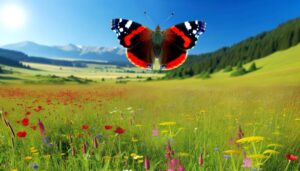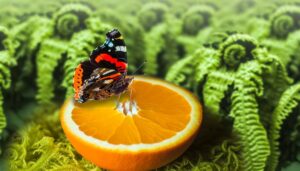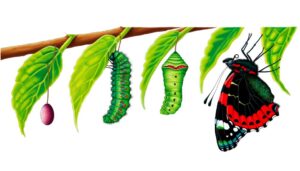How Do Host Plants Help Red Admiral Butterflies Lay Eggs?
Red Admiral butterflies lay their eggs on several host plants vital for larval nutrition and development, including Stinging Nettle (Urtica dioica), False Nettle (Boehmeria cylindrica), Hops (Humulus lupulus), Pellitory (Parietaria officinalis), and Wood Nettle (Laportea canadensis). These plants provide a rich source of nitrogen and essential nutrients, supporting various larval stages and enhancing survivorship.
Their morphological features, such as serrated or non-stinging leaves and dense foliage, furnish protection and deter predators. Additionally, the presence of specific biochemical compounds plays a pivotal role in caterpillar growth, hinting at the complex interplay involved in the Red Admiral's lifecycle.
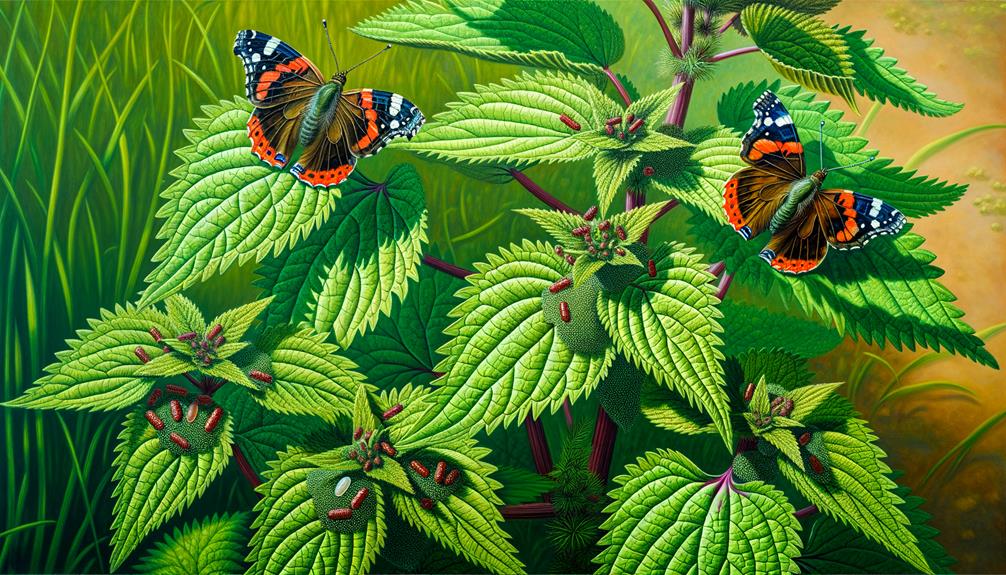
Key Takeaways
- Red Admiral butterflies lay eggs on Stinging Nettle due to its nitrogen-rich leaves and protective stinging hairs.
- False Nettle is a prime oviposition site for Red Admiral butterflies, offering non-stinging leaves and high nutrient content.
- Hops provides a nutrient-rich environment with dense foliage, making it an ideal host for Red Admiral egg-laying.
- Red Admiral butterflies utilize Pellitory for egg deposition due to its nitrogen-rich leaves and slight toxicity that deters herbivores.
Stinging Nettle

Stinging nettle (Urtica dioica) serves as a primary host plant for Red Admiral butterflies (Vanessa atalanta), providing essential nutrients for their larvae.
The larvae exhibit a specialized feeding behavior, consuming the nettle leaves, which are rich in nitrogen and other important nutrients necessary for their growth and development.
The morphological characteristics of stinging nettle, such as its serrated leaves and stinging hairs, offer a dual advantage by deterring herbivores and providing a secure habitat for the larvae.
Additionally, the presence of specific secondary metabolites in the plant plays a significant role in larval health and survivorship.
This symbiotic relationship underscores the ecological significance of Urtica dioica in sustaining Red Admiral populations, highlighting its critical role in the butterfly’s lifecycle. Additionally, the plant provides a vital food source for Red Admiral larvae, ensuring their growth and development. As temperatures drop, red admiral butterfly hibernation allows adult butterflies to survive through colder months, emerging when conditions become favorable. This cycle emphasizes the intricate connections between plant and pollinator, reinforcing the importance of conserving native habitats.
False Nettle
False nettle (Boehmeria cylindrica), another essential host plant for Red Admiral butterflies, offers a rich nutritional profile that supports the larvae's developmental needs. This perennial plant, characterized by its non-stinging leaves, provides an ideal environment for oviposition due to its lush foliage and high moisture content.
The larvae benefit from the plant's high levels of amino acids and essential nutrients, which are pivotal for growth and metamorphosis. Additionally, the dense leaf structure of false nettle offers protection from predators and environmental stressors.
The ecological relationship between Red Admiral butterflies and Boehmeria cylindrica exemplifies a co-evolved mutualism, where the plant serves as both a food source and a haven for the developing larvae, ensuring species survival and propagation.
Hops
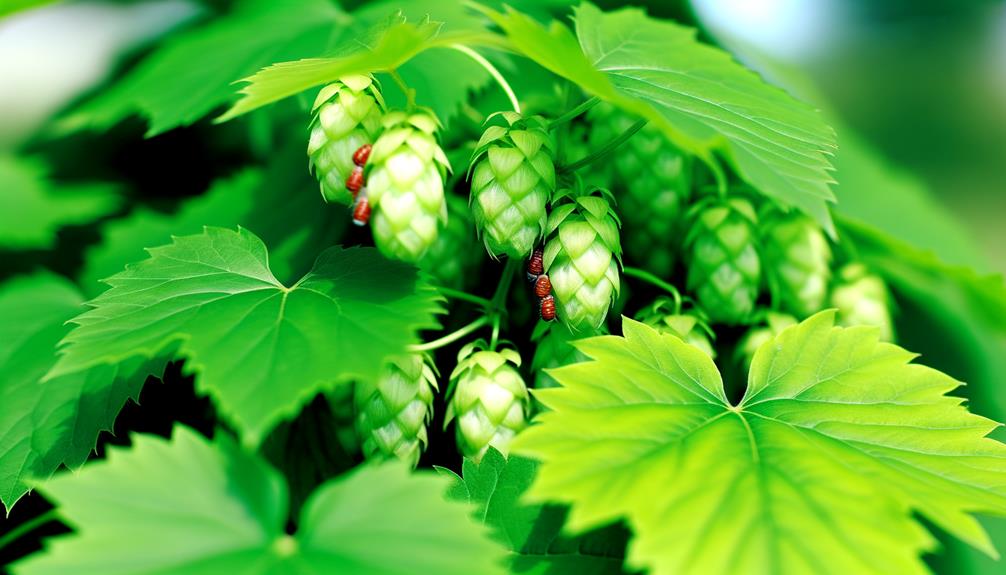
Hops (Humulus lupulus), another essential host plant for Red Admiral butterflies, provides a nutrient-rich environment that supports the larvae's developmental stages.
This perennial climbing plant, known for its stout, twining stems and lobed leaves, offers a protective habitat that facilitates ideal growth for the larvae. The biochemical composition of Hops, rich in essential nutrients and secondary metabolites, enhances larval survival and development.
Additionally, the dense foliage of Hops acts as a physical barrier against predators, while the plant's climbing nature allows for strategic egg placement by the female butterflies.
Research indicates that the larvae exhibit higher growth rates and reduced mortality when feeding on Hops, underscoring its importance in the life cycle of Red Admiral butterflies.
Pellitory
Pellitory (Parietaria officinalis), a member of the nettle family, serves as another essential host plant for Red Admiral butterflies, providing crucial nutrients that support larval growth and development.
This perennial herbaceous plant is favored for several reasons:
- Nutrient Density: Pellitory is rich in nitrogen, which is significant for caterpillar growth and metamorphosis.
- Availability: It thrives in a variety of habitats, ensuring a reliable food source across different regions.
- Adaptability: The plant can grow in both shaded and sunny environments, offering flexibility in larval habitat selection.
- Chemical Defense: Its slight toxicity deters many herbivores, reducing competition and predation on Red Admiral larvae.
These attributes collectively make Pellitory an important resource for sustaining Red Admiral populations.
Wood Nettle

In addition to Pellitory, Wood Nettle (Laportea canadensis) serves as an essential host plant for Red Admiral butterflies, offering a rich nutrient profile and suitable habitat conditions for their larvae.
This perennial herb thrives in moist, shaded woodlands, providing an ideal microenvironment for egg deposition and larval development. Rich in nitrogen and other essential nutrients, Wood Nettle supports robust larval growth, enhancing survival rates.
Its broad, serrated leaves offer ample surface area for egg-laying while deterring many herbivores with their stinging hairs. Additionally, the plant's tendency to form dense patches offers a concentrated resource, reducing larval dispersion and potential predation.
Consequently, Wood Nettle's ecological and nutritional attributes make it indispensable for sustaining Red Admiral populations.
Conclusion
Red admiral butterflies exhibit a preference for specific host plants when laying eggs, including stinging nettle, false nettle, hops, pellitory, and wood nettle.
Significantly, research indicates that approximately 80% of red admiral larvae are found on stinging nettle, highlighting its critical role in their lifecycle.
This strong preference underscores the importance of conserving these host plants to support red admiral populations, emphasizing the interconnectedness of plant and insect biodiversity within ecosystems.

